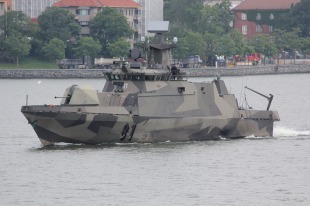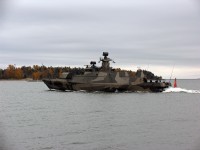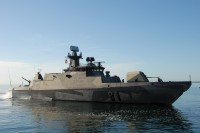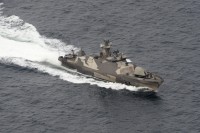Ракетні катери класу «Хаміна» (Rauma 2000)
Основна інформація
Головні розміри
Машина
- 2 * MTU 16V 538 TB93 diesels; 5520 kW
- 2 * Rolls Royce Kamewa 90SII waterjets
Персонал
Бойові сили та засоби
- Saab Ceros 200 with 9LV FCS (Saab)
- Consilium Selesmar maritime radar
- TRS-3D/16-ES multimode acquisition 3D radar (EADS)
- ANCS 2000 Combat Management System (EADS)
- MSSR 2000 I IFF (EADS)
- EOMS (SAGEM)
- Simrad Subsea Toadfish sonar
- Sonac/PTA towed array sonar (Finnyards)
- MASS (Multi Ammunition Soft-kill System) (Rheinmetall)
- Decoys: Philax chaff, IR flares
- Smoke system: Lacroix ATOS
- EMS: Matilda radar warning receiver (Thales)
- 1 * Bofors 57 mm/70 SAK Mk3
- 2 * 12.7 mm machine guns (NSV)
- 8 * Umkhonto-IR SAM (Denel)
- 4 * RBS-15 Mk2 SSM (Saab)
- 1 * rail for depth charges or mines (Sea Mine 2000)
The Hamina-class missile boat is a class of fast attack craft of the Finnish Navy. They are classified as «missile fast attack craft». The Hamina FACs are based at Upinniemi, and form the 7th Surface Warfare Squadron, part of the Finnish Coastal Fleet, together with the minelayers MLC Hämeenmaa, Porkkala and Pyhäranta.
The vessels were built in the late 1990s, early 2000s, and are the fourth generation of Finnish missile craft. The first vessel was ordered in December 1996 and the fourth was handed over on 19 June 2006. Since the launch of the Helsinki-class missile boats, all fast attack craft have been named after Finnish coastal cities. The class was previously known also as Rauma 2000 following its predecessor the Rauma class.
The four vessels form what the Finnish Navy calls Squadron 2000. Initially the Finnish Navy considered several different compositions for the new squadron, and at one point only two Hamina-class vessels and four Tuuli-class ACV were to have been built. After a strategic shift of the Finnish Navy's role, the composition of the Squadron 2000 followed suit. The Tuuli-class prototype was never fully equipped, nor fitted for operational use and its three sisters were cancelled, instead two more Hamina-class boats have been built; with some of the equipment intended for the Tuulis being used in the Haminas. The fourth and final Hamina-class vessel was delivered in summer 2006.
The squadron reached its full operational capability in 2008 and have greatly improved the surface- and air surveillance as well as air defense capability of the Finnish Navy. Their electronic surveillance suite also increases the quality of information available to military leaders.
All ships were built at Aker Finnyards in Rauma, Finland. The vessels have their home base at Upinniemi.
The vessel's hull is constructed of aluminum and the superstructures are constructed of re-enforced carbon fiber composite. The vessels have a very low displacement and are very maneuverable. They are equipped with water jets instead of propellers, which allow them to operate in very shallow waters and accelerate, slow down and turn in unconventional ways.
The Hamina class are very potent vessels, boasting surveillance and firepower capacities which are usually found in ships twice the size.
The Hamina class has been designed and constructed as stealth ships with minimal magnetic, heat and radar signatures.
The shape of the vessel has been designed to reduce radar signature. Metal parts have been covered with radar absorbent material, and the composite parts have radar absorbent material embedded in the structure. Radar transparent materials have been used where applicable.
Unlike glass fiber, carbon fiber blocks radio waves. This protects ship's electronics against electromagnetic pulse. In addition, it stops any radio frequency signals generated by ships electronic devices escaping outside. Except for the bridge, the vessel has no windows that would allow the signals to escape.
The vessel contains hardly any steel parts, thus generating very low magnetic field. The remaining magnetic field is actively canceled with electromagnets.
Exhaust gases can be directed underwater to minimize thermal signature, or up in the air to minimize sound in submarines direction. 50 nozzles around the decks and upper structures can be used to spray seawater on the vessel to cool it. In addition, the nozzles can be used to clean the ship after chemical attack or radioactive fall-out.
The Hamina class have the latest in surveillance and weapons technology all integrated into an intelligent command system. A Hamina class vessel can monitor about 200 kilometres (120 mi) of airspace and its Umkhonto surface-to-air missile system can simultaneously engage a maximum of eight aircraft, up to 14 kilometres (8.7 mi) away, while the vessel's anti-ship missiles have a range in excess of over 250 kilometres (160 mi).
The Hamina class' primary weaponry is four RBS-15 Mk.3 anti-ship missiles. The vessels are further equipped with a Bofors 57 mm gun against surface and aerial targets as well as the Umkhonto-IR surface-to-air missiles, MASS decoy system and two 12.7 mm heavy machine guns. It is also possible to use the ships for mine-laying.
In early 2018, Finland announced the mid-life upgrade program, which will equip all four boats in the class with new Swedish lightweight anti-submarine warfare torpedoes in the years 2023-2025 and extend the life of the boats to 2035.
Кораблі4
- Коментарі
 uk
uk en
en ru
ru




 Військово-Морські Сили Фінляндії
Військово-Морські Сили Фінляндії STX Finland
STX Finland


